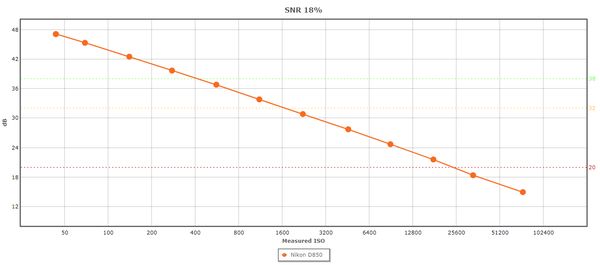ISO Low Settings
Sep 28, 2020 15:57:48 #
My manual for the Nikon D850 lists a normal range of ISO 64 to ISO 25600 and 3 low settings Lo 0.3 ~ISO 50, Lo 0.7 ~ISO 40 and Lo 1 ~ISO 32 plus 4 high settings. I have read that when increasing the ISO above the base ISO 64 that electric current is increased therefore increasing noise but what happens when decreasing ISO below 64? I would expect it to decrease electric current and reduce noise even more. If so why isn't the base ISO lower than 64. I have taken pictures at ISO 40 and not noticed any degradation of quality.
Sep 28, 2020 16:02:11 #
Sep 28, 2020 16:06:21 #
I believe using the low settings would give lower quality than the lowest 64. With those settings the lower ISO are achieved by software and not by lower the gain (which would reduce noise).
Sep 28, 2020 16:11:28 #
Sep 28, 2020 16:13:53 #
The Capt. wrote:
My manual for the Nikon D850 lists a normal range ... (show quote)
One low ISO advantage is that you can blur moving water (streams, waterfalls, ocean surf) without the hassle of an ND filter. The issue of ISO and noise was a very big deal with early digital photography but has diminished (but not disappeared) over the years. IMO with the latest cameras it’s not worth spending a lot time worrying about unless you are using really high ISO (>3200).
Sep 28, 2020 16:15:08 #
A very interesting topic . Most digital cameras do not go below 100 iso/asa . Film cameras used to go down as low as 16 iso/asa . When I do still life using flash this is a problem . My flash will not power down low enough to give me f -stop I want to be at . Yes I could use ND filter(on either lens or lighthead) but that would darken/dim my view . Funny most folx I think want a camera with high iso/asa but myself I'd rather have a camera with low asa/iso setting ability .
Sep 28, 2020 16:23:45 #
MW wrote:
One low ISO advantage is that you can blur moving water (streams, waterfalls, ocean surf) without the hassle of an ND filter.
Yes, that is why I went down to ISO 40.
Sep 28, 2020 16:24:28 #
Sep 28, 2020 16:36:38 #
Sep 28, 2020 16:42:24 #
Ysarex
Loc: St. Louis
The Capt. wrote:
My manual for the Nikon D850 lists a normal range of ISO 64 to ISO 25600 and 3 low settings Lo 0.3 ~ISO 50, Lo 0.7 ~ISO 40 and Lo 1 ~ISO 32 plus 4 high settings. I have read that when increasing the ISO above the base ISO 64 that electric current is increased therefore increasing noise but what happens when decreasing ISO below 64?
That's not accurate. There's no electric current being increased or decreased. You do have a camera with dual impedance channels so there is a current change that takes place when you switch from ISO values below 400 to values of 400 and above.
With the ISO values below 64 your camera simply implements ISO in the camera image processor. No change to implement ISO takes place in the creation of the raw file. You do run the risk of clipping highlights with the increased exposure assuming you follow the the camera meter -- 32 is a full stop more exposure.
This may help explain what's happening: https://www.photonstophotos.net/Charts/PDR.htm#Nikon%20D850
The Capt. wrote:
I would expect it to decrease electric current and reduce noise even more. If so why isn't the base ISO lower than 64. I have taken pictures at ISO 40 and not noticed any degradation of quality.
Sep 28, 2020 16:59:41 #
The Capt. wrote:
My manual for the Nikon D850 lists a normal range ... (show quote)
I shoot Canon, but this is what my manual tells me: As L (equivalent to ISO 50) is an expanded ISO speed setting, the dynamic range will be somewhat narrower compared with the standard setting.
I bet Nikon is similar.
Sep 28, 2020 18:14:17 #
That's a good topic to bring up. I just selected the D850 in the DxO sensor comparison tool. Both the signal to noise ratio and the dynamic range improve all the way to the lowest ISO (under ISO 50 on the charts).
Sep 28, 2020 18:23:51 #
Ysarex
Loc: St. Louis
CO wrote:
That's a good topic to bring up. I just selected the D850 in the DxO sensor comparison tool. Both the signal to noise ratio and the dynamic range improve all the way to the lowest ISO (under ISO 50 on the charts).
Interesting then as Bill Claff's data says the opposite: https://www.photonstophotos.net/Charts/PDR.htm#Nikon%20D850
Sep 28, 2020 18:32:48 #
Ysarex wrote:
Interesting then as Bill Claff's data says the opposite: https://www.photonstophotos.net/Charts/PDR.htm#Nikon%20D850
strange. My canon doesn't lose anything below 100 either on that chart.
Sep 28, 2020 19:47:44 #
Ysarex wrote:
Interesting then as Bill Claff's data says the opposite: https://www.photonstophotos.net/Charts/PDR.htm#Nikon%20D850
No. They're very close to the same. The DxO chart of dynamic range shows an almost flat graph around ISO 50. The Photons to Photos chart shows the graph to be flat around ISO 50.
If you want to reply, then register here. Registration is free and your account is created instantly, so you can post right away.




